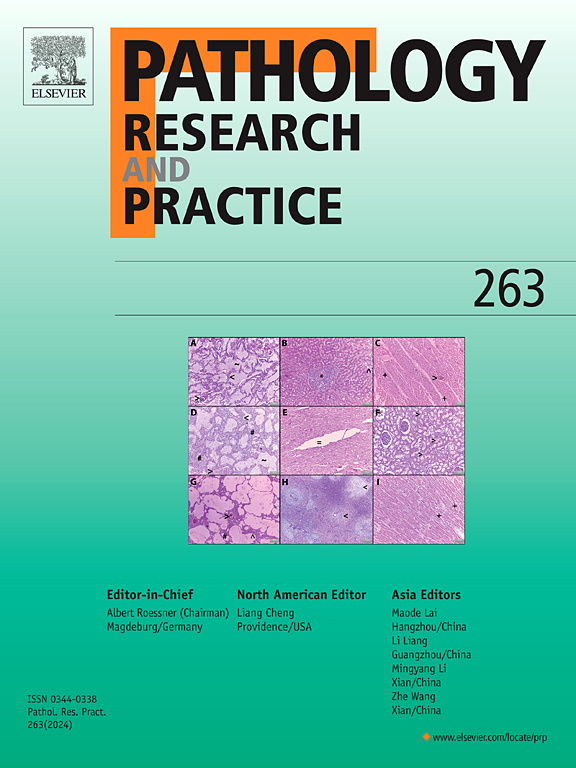节律紊乱和功能障碍:多囊卵巢综合征的时间生物学观点。
IF 3.2
4区 医学
Q2 PATHOLOGY
引用次数: 0
摘要
多囊卵巢综合征(PCOS)是一种多因素内分泌代谢紊乱,以生殖异常、高雄激素和胰岛素抵抗为特征。近年来时间生物学的研究进展表明,昼夜节律系统失调是多囊卵巢综合征的发病机制和临床表现的一个重要因素。这篇综述探讨了PCOS患者的代谢和激素功能障碍与生物钟紊乱、褪黑激素动态改变和不规则睡眠-觉醒周期的关系。我们强调了卵巢、肝脏和下丘脑组织中时钟基因如clock、BMAL1和PER1的异常表达与排卵失败、胰岛素抵抗和雄激素过量有关的新证据。此外,褪黑激素,一种关键的昼夜节律激素,在多囊卵巢综合征中显示出系统和卵泡特征的改变,影响卵泡生成、氧化应激和类固醇生成。此外,本综述深入探讨了昼夜节律线索调节下丘脑-垂体-卵巢轴的神经内分泌途径,以及它们的破坏如何导致生殖障碍。鉴于这些发现,我们讨论了时间治疗方法,包括褪黑激素补充,限时喂养,光疗和昼夜节律定时药物治疗,作为个性化和临时调整多囊卵巢综合征治疗的新兴策略。尽管在临床标准化和基于生物标志物的分层方面存在局限性,但时间医学为传统的多囊卵巢综合征治疗提供了一个有希望的辅助手段。通过将多囊卵巢综合征视为一种时间失调的疾病,本综述倡导在理解和治疗多囊卵巢综合征方面的范式转变,为昼夜节律知情的临床护理铺平道路。本文章由计算机程序翻译,如有差异,请以英文原文为准。
Disrupted rhythms and dysfunction: A chronobiological perspective on polycystic ovary syndrome
Polycystic Ovary Syndrome (PCOS) is a multifactorial endocrine-metabolic disorder characterized by reproductive irregularities, hyperandrogenism, and insulin resistance. Recent advances in chronobiology have introduced a compelling narrative suggesting that dysregulation in circadian system is a contributing factor in the pathogenesis and clinical manifestation of PCOS. This review explores how disrupted biological timing—reflected in misaligned central and peripheral clocks, altered melatonin dynamics, and irregular sleep-wake cycles—intersects with metabolic and hormonal dysfunctions in PCOS. We highlight emerging evidence linking aberrant expression of clock genes such as CLOCK, BMAL1, and PER1 in ovarian, hepatic, and hypothalamic tissues to ovulatory failure, insulin resistance, and androgen excess. Moreover, melatonin, a key circadian hormone, demonstrates altered systemic and follicular profiles in PCOS, influencing folliculogenesis, oxidative stress, and steroidogenesis. Further, this review delves into the neuroendocrine pathways by which circadian cues modulate the hypothalamic-pituitary-ovarian axis and how their disruption may contribute to reproductive impairment. In light of these findings, we discuss chronotherapeutic approaches—including melatonin supplementation, time-restricted feeding, light therapy, and circadian-timed pharmacotherapy—as emerging strategies for personalized and temporally aligned PCOS treatment. Despite limitations in clinical standardization and the need for biomarker-based stratification, chronomedicine offers a promising adjunct to traditional PCOS management. By framing PCOS as a disorder of temporal dysregulation, this review advocates for a paradigm shift in both understanding and treating the syndrome, paving the way toward circadian-informed clinical care.
求助全文
通过发布文献求助,成功后即可免费获取论文全文。
去求助
来源期刊
CiteScore
5.00
自引率
3.60%
发文量
405
审稿时长
24 days
期刊介绍:
Pathology, Research and Practice provides accessible coverage of the most recent developments across the entire field of pathology: Reviews focus on recent progress in pathology, while Comments look at interesting current problems and at hypotheses for future developments in pathology. Original Papers present novel findings on all aspects of general, anatomic and molecular pathology. Rapid Communications inform readers on preliminary findings that may be relevant for further studies and need to be communicated quickly. Teaching Cases look at new aspects or special diagnostic problems of diseases and at case reports relevant for the pathologist''s practice.

 求助内容:
求助内容: 应助结果提醒方式:
应助结果提醒方式:


